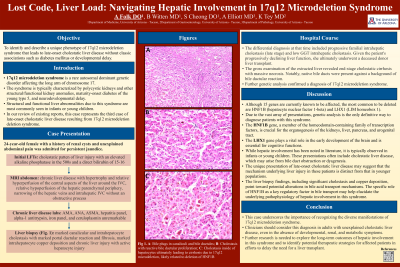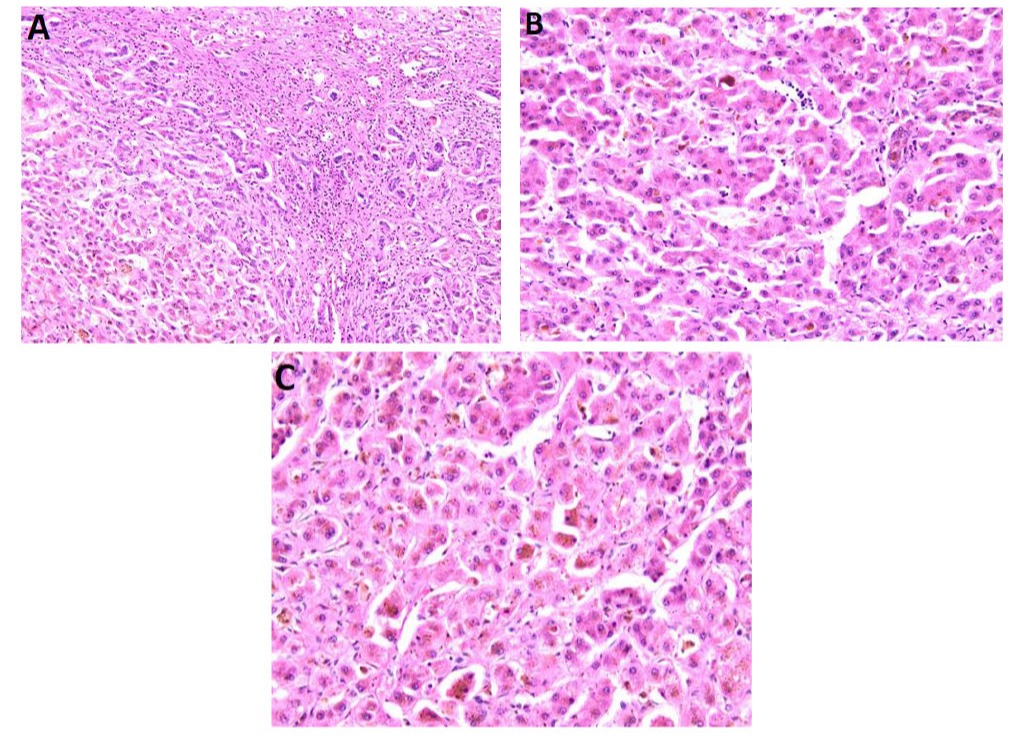Sunday Poster Session
Category: Liver
P1287 - Lost Code, Liver Load: Navigating Hepatic Involvement in 17q12 Microdeletion Syndrome
Sunday, October 27, 2024
3:30 PM - 7:00 PM ET
Location: Exhibit Hall E

Has Audio
.jpg)
Akira Folk, DO
University of Arizona College of Medicine
Tucson, AZ
Presenting Author(s)
Brandon Witten, MD1, Akira Folk, DO1, Samuel H. Cheong, DO2, Alexis Elliott, MD1, Kai Rou Tey, MD1
1University of Arizona College of Medicine, Tucson, AZ; 2Banner - University of Arizona, Tucson, AZ
Introduction: 17q-12 recurrent deletion syndrome is a rare cause of chronic liver disease in adults. It is characterized by a triad of renal cysts, diabetes and developmental delay. In this case report we identify a unique phenotype of this rare condition leading to cirrhosis.
Case Description/Methods: 24 year old female with a 7 year history of renal cysts and unexplained presented for evaluation at a tertiary care hospital for persistent jaundice. Initial lab work was significant for a cholestatic pattern of liver injury, alkaline phosphatase elevated in the 500s with a direct bilirubin of 15-16. MRI showed chronic liver disease with hypertrophy and relative hyper perfusion of the central aspects of the liver around the IVC, and relative hypoperfusion of the hepatic parenchymal periphery. Additionally there was narrowing of the hepatic veins and intrahepatic IVC but no obstructive process was visualized. Serologic work-up for chronic liver disease including alpha 1 anti-trypsin, iron panels, ceruloplasmin, ANA, AMA, ASMA, and hepatitis panel in the initial work-up stage was negative.
Liver biopsy was eventually obtained which showed marked canalicular and intrahepatocyte cholestasis with marked portal ductular reaction and fibrosis. Additionally there was marked intrahepatocyte copper deposition as well as chronic liver injury with active hepatocyte injury. Differential diagnosis at that time included progressive familial intrahepatic cholestasis (late stage) and low GGT intrahepatic cholestasis. Due to progressively decreasing liver function she underwent deceased donor liver transplant. Gross examination of the extracted liver showed end-stage cholestatic cirrhosis with massive necrosis. Native bile ducts were present in a background of bile ductular reaction. Genetic analysis revealed a diagnosis of 17q12 recurrent deletion syndrome. Within this deleted segment of genome is HNF1b, a gene encoding a regulatory factor for bile transport.
Discussion: 17q-12 recurrent deletion syndrome affects a wide range of organ systems with multi-cystic kidneys, diabetes and developmental being the classic presentation. Liver involvement has been described in the literature occurring usually in infants or younger children. In our review of existing reports this case represents the third case of late onset cholestatic liver disease resulting from 17q12 recurrent deletion syndrome. This case is also unique in that the presentation included only late-onset cholestatic liver disease and not diabetes or developmental delay.

Disclosures:
Brandon Witten, MD1, Akira Folk, DO1, Samuel H. Cheong, DO2, Alexis Elliott, MD1, Kai Rou Tey, MD1. P1287 - Lost Code, Liver Load: Navigating Hepatic Involvement in 17q12 Microdeletion Syndrome, ACG 2024 Annual Scientific Meeting Abstracts. Philadelphia, PA: American College of Gastroenterology.
1University of Arizona College of Medicine, Tucson, AZ; 2Banner - University of Arizona, Tucson, AZ
Introduction: 17q-12 recurrent deletion syndrome is a rare cause of chronic liver disease in adults. It is characterized by a triad of renal cysts, diabetes and developmental delay. In this case report we identify a unique phenotype of this rare condition leading to cirrhosis.
Case Description/Methods: 24 year old female with a 7 year history of renal cysts and unexplained presented for evaluation at a tertiary care hospital for persistent jaundice. Initial lab work was significant for a cholestatic pattern of liver injury, alkaline phosphatase elevated in the 500s with a direct bilirubin of 15-16. MRI showed chronic liver disease with hypertrophy and relative hyper perfusion of the central aspects of the liver around the IVC, and relative hypoperfusion of the hepatic parenchymal periphery. Additionally there was narrowing of the hepatic veins and intrahepatic IVC but no obstructive process was visualized. Serologic work-up for chronic liver disease including alpha 1 anti-trypsin, iron panels, ceruloplasmin, ANA, AMA, ASMA, and hepatitis panel in the initial work-up stage was negative.
Liver biopsy was eventually obtained which showed marked canalicular and intrahepatocyte cholestasis with marked portal ductular reaction and fibrosis. Additionally there was marked intrahepatocyte copper deposition as well as chronic liver injury with active hepatocyte injury. Differential diagnosis at that time included progressive familial intrahepatic cholestasis (late stage) and low GGT intrahepatic cholestasis. Due to progressively decreasing liver function she underwent deceased donor liver transplant. Gross examination of the extracted liver showed end-stage cholestatic cirrhosis with massive necrosis. Native bile ducts were present in a background of bile ductular reaction. Genetic analysis revealed a diagnosis of 17q12 recurrent deletion syndrome. Within this deleted segment of genome is HNF1b, a gene encoding a regulatory factor for bile transport.
Discussion: 17q-12 recurrent deletion syndrome affects a wide range of organ systems with multi-cystic kidneys, diabetes and developmental being the classic presentation. Liver involvement has been described in the literature occurring usually in infants or younger children. In our review of existing reports this case represents the third case of late onset cholestatic liver disease resulting from 17q12 recurrent deletion syndrome. This case is also unique in that the presentation included only late-onset cholestatic liver disease and not diabetes or developmental delay.

Figure: A: Bile plugs in canaliculi and bile ductules
B: Cholestasis with reactive bile ductular proliferation
C: Cholestasis inside of hepatocytes ultimately leading to cirrhosis due to 17q12 microdeletion likely related to deletion of HNF1B
B: Cholestasis with reactive bile ductular proliferation
C: Cholestasis inside of hepatocytes ultimately leading to cirrhosis due to 17q12 microdeletion likely related to deletion of HNF1B
Disclosures:
Brandon Witten indicated no relevant financial relationships.
Akira Folk indicated no relevant financial relationships.
Samuel Cheong indicated no relevant financial relationships.
Alexis Elliott indicated no relevant financial relationships.
Kai Rou Tey indicated no relevant financial relationships.
Brandon Witten, MD1, Akira Folk, DO1, Samuel H. Cheong, DO2, Alexis Elliott, MD1, Kai Rou Tey, MD1. P1287 - Lost Code, Liver Load: Navigating Hepatic Involvement in 17q12 Microdeletion Syndrome, ACG 2024 Annual Scientific Meeting Abstracts. Philadelphia, PA: American College of Gastroenterology.

